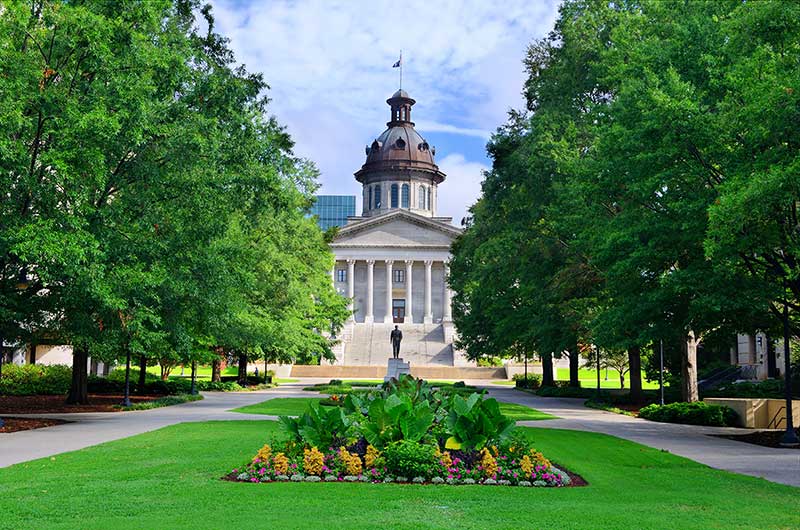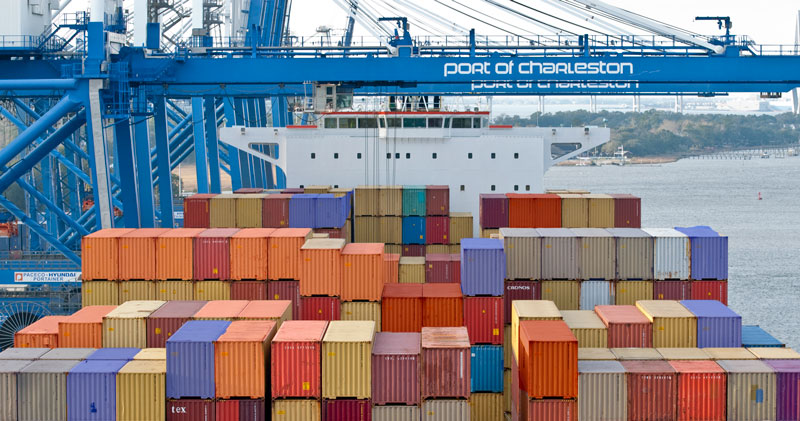-
Why SC
-

Aggressive incentives position industries for growth
-
-
Industries
-
-
State Economy
-
-
International
-

Expand to the US
Contact our network around the globe
-
-
About
-

Our recruitment track record and awarded incentives
-
- Contact
In South Carolina, only local governments may levy property taxes.
A company’s property tax liability is a function of: Property Value x Assessment Ratio x Millage.
To determine Fair Market Value, real property is appraised, while tangible personal property is recorded at cost and then depreciated based on a statutory depreciation rate (for manufacturers) and income tax depreciation (for other businesses). The Fair Market Value is then assessed at rates established in the South Carolina Constitution. The local millage rate is applied to the assessed value to determine the property taxes. Millage rates in South Carolina are site specific and set annually by local government. A mill is equal to $0.001.
Property Tax Exemptions may include inventories (raw materials, work-in-progress, finished goods), intangibles (stocks, dividends, interest) and pollution control equipment. A partial Property Tax Exemption, called an abatement, may be made available to manufacturing, research and development, corporate headquarters, office and distribution facilities meeting certain requirements. Companies may also be able to negotiate a Fee-in-Lieu (FILOT) of property taxes, which can greatly reduce their property tax liability. This property tax incentive is offered at the discretion of local governments. Companies investing as little as $2.5 million dollars may negotiate this exemption with the county in which they locate. This incentive creates significant savings for companies by lowering the assessment ratio from 10.5% for manufacturers to as low as 6% for up to 30 years and lock the millage rate or make it adjustable every five years during the term of the agreement. Furthermore, the millage may be held lower than if the property were not under a FILOT.
For additional information regarding the South Carolina taxes, contact the South Carolina Department of Revenue.
For a manufacturer, 42.8571% of the property tax value of manufacturing property assessed for property tax purposes will be exempt from property taxation; provided, however, that the total amount of the exemption for all entities in the State for that fiscal year will not exceed $170 million. For any year in which the amount is projected to exceed $170 million, the exemption amount shall be proportionally reduced. Please note that this exemption does not apply to property under a Fee-in-Lieu agreement.
-
Property Taxes
Valuation and Assessment
The Department of Revenue determines the fair market value of a business’ real property (land and building) and personal property (machinery and equipment) to assure equitable local treatment. The fair market value is then assessed at rates established in the State Constitution. For manufacturers, real and personal property are both assessed at 10.5%. The assessment ratio for all other businesses is 6% for real property and 10.5% for personal property. (For homeowners, primary residences are assessed at 4%.)
Depreciation
Depreciation rates are determined by the Department of Revenue based on the type of personal property. For manufacturers, personal property is allowed to depreciate annually at a rate set in law according to the company’s primary function (the most common depreciation rate is 11% per year). For all other businesses, the personal property is allowed to depreciate annually (once it is placed in service) at the rate claimed by the company for income tax purposes. The company will be allowed to depreciate its personal property to a level of 10% of the original property value. Please note that the Department of Revenue makes the final determination of the allowable depreciation.
Millage
The local millage rate is applied to the assessed depreciated value to determine taxes. Millage rates in South Carolina are site specific and set annually by local government. A mill is equal to $0.001.
-
Property Tax Exemptions
In support of business, South Carolina exempts three classes of property from local property taxation:
- All inventories (raw materials, work-in-progress and finished goods);
- All intangible property; and
- All pollution control equipment.
For a manufacturer, 42.8571% of the property tax value of manufacturing property assessed for property tax purposes will be exempt from property taxation; provided, however, that the total amount of the exemption for all entities in the State for that fiscal year will not exceed $170 million. For any year in which the amount is projected to exceed $170 million, the exemption amount shall be proportionally reduced. Please note that this exemption does not apply to property under a Fee-in-Lieu agreement.
-
Property Tax Incentives
5-Year Property Tax Abatement
By law, manufacturers (investing $50,000 or more) and distribution or corporate headquarters facilities (investing $50,000 or more and creating 75 new jobs in year 1) are entitled to a five-year property tax abatement from county operating taxes. This abatement usually represents an offset of up to 20% to 50% of the total millage, depending on the county. The abatement does not include the school portion of the local millage.
Please note that the tax abatement on investment is in effect for five years only. In year 6, the abatement terminates, and the property is taxed at the millage rate in effect at that time.
The five–year property tax abatement is not available for property placed under a Fee-in-Lieu agreement.
-
Fee-in-lieu of Property Taxes (FILOT)
Under this program, companies making substantial capital investments may negotiate a lower assessment ratio and stabilize millage rates for up to 30 years. The long-term savings of the FILOT is based on the actual investment and is dependent on both the assessment and millage rates negotiated with the county.
South Carolina law allows a county to negotiate with a company for a FILOT agreement if total capital investment is $2.5 million or greater. By law, the company has five years to meet the minimum investment threshold, and the county can offer an additional five-year extension to complete the project. The company may include both real and personal property under the FILOT agreement. However, property that has been on the tax rolls in the state previously, including existing buildings, is not eligible for the FILOT. (This restriction is waived for companies investing an additional $45 million or more in new investment.)
The FILOT may result in substantial benefits for a company:
- Savings: Payments to local government are significantly reduced through the negotiation of a lower assessment rate (from 10.5% to as low as 6%). The company may also negotiate a locked-in millage rate for up to 30 years or a five-year adjustable rate for the property that is subject to the FILOT. With a FILOT, personal property depreciates, but real property is fixed at the original cost for the life of the fee. However, the county and the company may instead provide that any real property subject to the FILOT may be reported at its fair market value as determined by the appraisal of the Department of Revenue and may be re-appraised every five years.
- Replacement Property: Property that is replacing property previously under the FILOT is allowed to go under the agreement up to the original income tax basis of the original fee property it is replacing at any time during the agreement.
- Additional Savings for Substantial Capital Investments: If a company is investing more than $400 million, or investing more than $150 million and creating at least 125 net new jobs, a “Super Fee” is negotiable. This fee can further lower the assessment rate to as low as 4%.
-
Textile Revitalization Credit
There are credits for rehabilitating abandoned textile mill sites that encourage businesses to renovate, improve and redevelop abandoned textile mill sites.
Sites that are eligible are abandoned sites directly used for textile manufacturing operations or ancillary uses for, or designed for use by, textile manufacturing. “Abandoned” means that at least 80% of the site has been closed for a period of at least one year.
A company that improves, renovates or redevelops an eligible site may be eligible for one of two tax credits:
- A credit against income taxes or license taxes equal to 25% of the rehabilitation expenses. This credit is to be taken in equal installments over five years beginning with the tax year in which the site is placed in service. The credit may offset up to 100% of income or license tax liability. Unused credits can be carried forward up to five years. In this case, the taxpayer must file a Notice of Intent to Rehabilitate with the Department of Revenue before receiving building permits.
- A credit against real property taxes equal to 25% of the rehabilitation expenses of an eligible site multiplied by the local taxing ratio of each local taxing entity that has consented to the tax credit. This credit can offset up to 75% of property taxes for a period of up to eight years. To receive this credit, the county or municipality in which the site is located must determine the eligibility of the site and the proposed project. A majority vote of the local governing body must approve the project, and the determinations and approval must be made by public hearing and ordinance. In this case, the taxpayer must file a Notice of Intent to Rehabilitate with the local government before incurring rehabilitation expenses.
-
Revitalization of Abandoned Building Credit
In order to qualify for this credit, taxpayer must improve, renovate or redevelop an eligible site for income producing purposes and incur rehabilitation expenses in an amount
- Greater than $250,000 for building in unincorporated area of a county or in a municipality of a county with a population of more than 25,000 persons;
- Greater than $150,000 for building in unincorporated area of a county or in a municipality of a county with a population of at least 1,000 persons but less than 25,000 persons; or
- Greater than $75,000 for building in unincorporated area of a county or in a municipality of a county with a population of less than 1,000 persons.
Sites that are eligible are buildings or structures, at least 66% of which has been closed continuously or otherwise nonoperational for at least five years (excluding a building used immediately preceding as a single-family residence) from the date that the taxpayer files a Notice of Intent to Rehabilitate.
A qualifying taxpayer may be eligible for one of two tax credits:
- A credit against income taxes or license taxes equal to 25% of the rehabilitation expenses. This credit is to be taken in equal installments over three years beginning with the tax year in which the site is placed in service. The credit can offset up to 100% of the income or license tax liability and the credit may not exceed $750,000 in any one tax year. Unused credits can be carried forward up to five years. In this case, the taxpayer must file the Notice of Intent to Rehabilitate with the Department of Revenue before receiving building permits.
- A credit against real property taxes equal to 25% of the rehabilitation expenses of an eligible site multiplied by the local taxing ratio of each local taxing entity that has consented to the tax credit. This credit can offset up to 75% of property taxes for a period of up to eight years. To receive this credit, the county or municipality in which the site is located must determine the eligibility of the site and the proposed project. A majority vote of the local governing body must approve the project, and the determinations and approval must be made by public hearing and ordinance. In this case, the taxpayer must file the Notice of Intent to Rehabilitate with the county or municipality before incurring expenses.
Did You Know? Companies that rehabilitate abandoned facilities may be eligible for tax credits. These credits encourage businesses to renovate, improve, and redevelop these abandoned areas.












